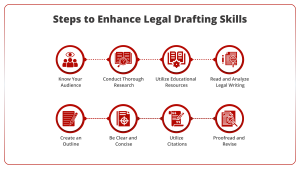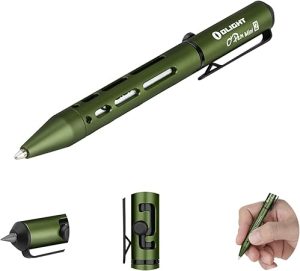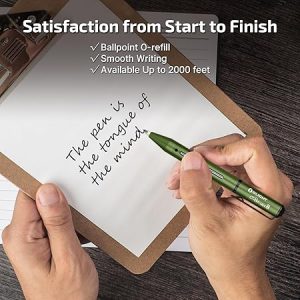Every word you write while drafting legal documents matters—a slight mistake or unclear wording can lead to significant legal problems, including disputes or court cases. Here are a few significant hurdles you might face when drafting legal documents:
- Avoiding Ambiguities: You must be careful with your wording to ensure each term is clear and specific. This can be tricky because legal language needs to be precise yet understandable.
- Keeping Up to Date: Laws change constantly, and your documents need to reflect the latest rules and regulations. This means you must continuously study and adapt, which can be demanding.
You must be aware of these challenges as they set the foundation for the drafting process, which begins with creating the first draft.
At the Las Vegas conference organized by Destination CLEs, you can enhance your legal writing skills with a workshop that will equip you with strategies to draft clear and precise legal documents and emails. Learn how to communicate complex information effectively, ensuring clients and judges can easily understand your arguments.
This blog will explore strategies for crafting clear and effective legal drafts, ensuring precision and clarity in your legal documents.
The Importance of Precision in Legal Document Drafting
A study by the American Bar Association reveals that 68% of legal malpractice claims are related to errors in document drafting. This results in significant financial losses for law firms and can have severe repercussions for clients, including losing rights or remedies.
A recent study highlights that substantive errors make up over half of the alleged mistakes in malpractice claims. Clear and precise language in legal documents is essential because vague terms can cause misunderstandings, potentially leading to expensive lawsuits or document invalidation. Accurate language captures the parties’ true intentions and complies with relevant laws and regulations.
The Structure and Essential Elements of Legal Documents
Explore the elements that make legal documents clear, structured, and effective.
Title and Heading
Begin the document with a title that outlines its subject. Use headings to list specific details like case names, court jurisdiction, docket numbers, and dates to establish the legal context quickly for the reader.
Table of Contents
A table of contents in longer documents is essential for helping readers easily navigate through different sections. It outlines the organization of the document and allows quick access to specific parts.
Introduction
The introduction should briefly outline the subject matter, state the document’s objective, and highlight the issues that will be addressed. This section prepares the reader for the detailed discussion that follows.
Statement of Facts
This section provides a clear, chronological account of the facts pertinent to the legal issues. Detailing these facts accurately and neutrally is crucial to preserving objectivity and credibility.
Legal Issues Presented
Identify and clearly state the legal questions or issues that the document will address. This segment guides the reader through the subsequent legal analysis and supports structured legal reasoning.
Arguments and Analysis
Each argument should be presented and supported with appropriate legal precedents and statutory references. These references should be carefully applied to the facts of the case to strengthen the argument.
Counter Arguments
Including relevant counterarguments shows a comprehensive understanding of the legal issues and enhances the document’s persuasive power by preemptively addressing potential opposition.
Conclusion
Conclude the document by summarizing the important points and reinforcing the proposed legal position or recommendation. The conclusion should be impactful, reinforcing the document’s arguments and leaving a clear impression of the advocated position.
Signature and Certification
Finally, if required, include a signature and certification block to authenticate the document. This section verifies the author’s identity and the accuracy of the information and arguments presented.
Steps to Enhance Legal Drafting Skills
Here is a list of eight steps to help draft a legal document and improve your legal drafting skills.
Step 1: Know Your Audience
Understanding your audience is essential when preparing legal documents. Determine whether your reader is a client, a fellow attorney, or a judge, and adjust the tone accordingly—informative for colleagues, persuasive for the courtroom, or clear and straightforward for clients.
Study exemplary legal writings to adopt effective styles and techniques. Use legal terminology to ensure precision while keeping the text accessible to lay readers. Aim for clear, concise language to articulate complex concepts, and consider peer feedback to refine your writing.
Step 2: Conduct Thorough Research
Comprehensive research supports effective legal writing. Begin your research from a neutral perspective to keep your document objective. Deepen your understanding by familiarizing yourself with relevant legal precedents and statutes. Analyze documents crafted by seasoned legal professionals to handle complex legal issues proficiently.
Step 3: Utilize Educational Resources
Educational resources can significantly improve your legal drafting. Enroll in legal writing courses or attend seminars to sharpen your skills. Regular writing exercises help you apply new techniques and insights from educational resources.
Step 4: Read and Analyze Legal Writing
Examine various documents to see how experts construct persuasive arguments and structure their cases. Incorporate professional writing techniques into your drafts to enhance clarity and argumentative power.
Step 5: Create an Outline
A structured outline ensures your arguments are presented logically. Clearly state your document’s central argument or purpose. Arrange your arguments logically to build your case effectively.
Step 6: Be Clear and Concise
Avoid unnecessary jargon. Use technical terms only when necessary, and explain them when you do. Simplify complex sentences and ensure your language is accessible. When presenting strong arguments, stay courteous and professional. Write in an active voice to make your writing more direct and dynamic.
Step 7: Utilize Citations
Support your arguments with well-formatted citations. Consistently use a recognized legal citation format to add credibility. Cite statutes, case law, and respected commentaries to strengthen your arguments.
Step 8: Proofread and Revise
Check your draft for any errors or unclear passages. Refine your wording to ensure each sentence conveys its intended message.
By following these steps, you can develop strong legal drafting skills that will serve you well throughout your legal career.
Essential Legal Documents and Legal Considerations
Below is an overview of common types of legal documents., along with drafting tips and relevant legal considerations for each:
| Type of Document | Drafting Tips | Legal Considerations in the U.S. |
| Contracts |
|
|
| Pleadings |
|
|
| Memorandums |
|
|
| Wills and Trusts |
|
|
Resources and Courses for Enhancing Legal Drafting Skills
For legal professionals looking to refine their legal writing skills, various courses and tools are available to help them master the art of legal drafting. Here is a list of some effective educational opportunities and resources:
- Practical Legal Writing Courses
Introduction to Legal Research and Writing: This entry-level course covers case analysis and statute interpretation basics.
Advanced Legal Drafting: For those with more experience, this course focuses on developing complex arguments and detailed document preparation.
Legal Writing Workshops: These sessions, offered by law schools and legal groups, provide hands-on practice and feedback from seasoned professionals.
- Tools for Effective Legal Drafting
Legal Research Databases: Access important resources like Westlaw and LexisNexis to support informed legal drafting.
Document Automation Software: Use tools like Clio and NetDocuments to create accurate and consistent legal documents quickly.
Style Guides: Reference The Bluebook and The Chicago Manual of Style to ensure your documents meet industry standards.
- Networking and Continuous Learning
Engage with Peers: Networking opportunities during courses and workshops allow you to connect with other legal professionals, share insights, and learn from each other.
Follow Legal Writing Blogs: Follow blogs to stay updated with new practices and insights.
How Can Continuing Legal Education (CLE) Insights Enhance Your Legal Drafting Skills?
Continuing Legal Education (CLE) is required to maintain your legal license. Participating in CLE programs exposes you to the latest developments, innovative strategies, and expert insights across diverse legal fields.
What do you gain from CLE? You acquire deep insights into complex topics such as emerging technologies, law updates, or new mediation techniques. These sessions deepen your understanding of challenging legal issues, enhancing your ability to create precise, informed, and persuasive legal documents.
Applying what you learn in CLE to your drafts can significantly elevate their quality. For instance, knowledge of new regulatory frameworks or the implications of technological advancements can help you draft more robust contracts or pleadings. Similarly, mastering new dispute resolution approaches can improve how you structure settlement agreements or negotiation tactics.
You can explore the enriching “Learning in Lisbon” conference, organized by Destination CLEs and set for October 12-19, 2024. Lawyers can earn 8 CLE hours, including three on ethics, amidst Lisbon’s captivating beauty and see how such experiences can significantly benefit your legal practice.
Explore the World While Meeting Your CLE Requirements with Destination CLEs
Destination CLEs redefine the way legal professionals meet their continuing education requirements. Our conferences blend educational opportunities with cultural immersion in some of the world’s most captivating cities.
Why Choose Destination CLEs?
- Meet CLE Requirements: Fulfill your mandatory CLE credits through engaging, high-quality seminars in stunning global locations.
- Transformative Learning: Turn the usual lecture-based learning on its head by engaging in sessions as dynamic as the destinations.
- Networking Opportunities: Connect with peers worldwide, expanding your professional network in settings that encourage collaboration and growth.
- All-Inclusive Experience: Enjoy comprehensive packages that cover educational sessions, accommodations, and unique cultural experiences, making your learning adventure seamless and memorable.
- Efficient Credit Earning: Earn required CLE credits efficiently, with schedules that balance professional development and exploration.
Plan your next educational journey with Destination CLEs and ensure extraordinary professional development. Our 2024-2025 lineup includes diverse locales such as Lisbon, Puerto Vallarta, Dubai, Havana, and an Alaska Cruise—each offering a distinct blend of legal education and local culture.
Secure your spot today and become part of a community dedicated to professional growth and networking.
DestinationCLEs.com is a participant in the Amazon Services LLC Associates Program, an affiliate advertising program designed to provide a means for sites to earn advertising fees by advertising and linking to Amazon dot com.











